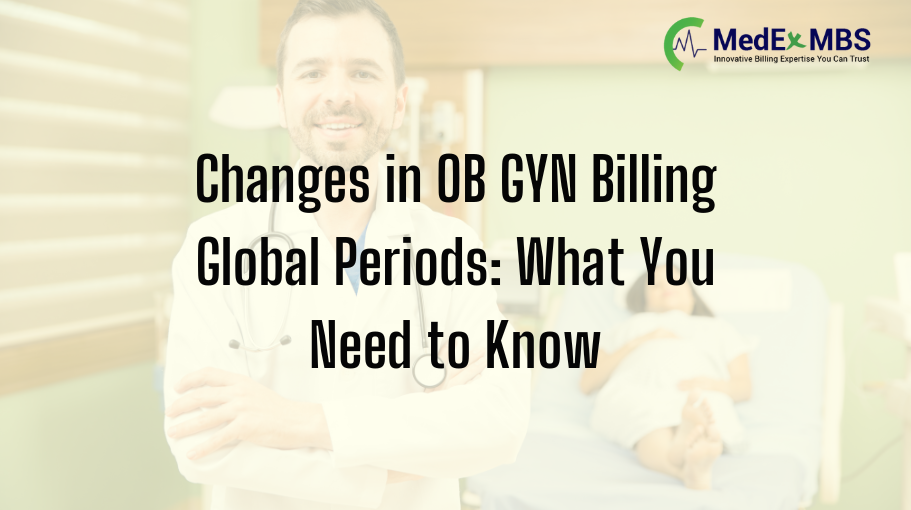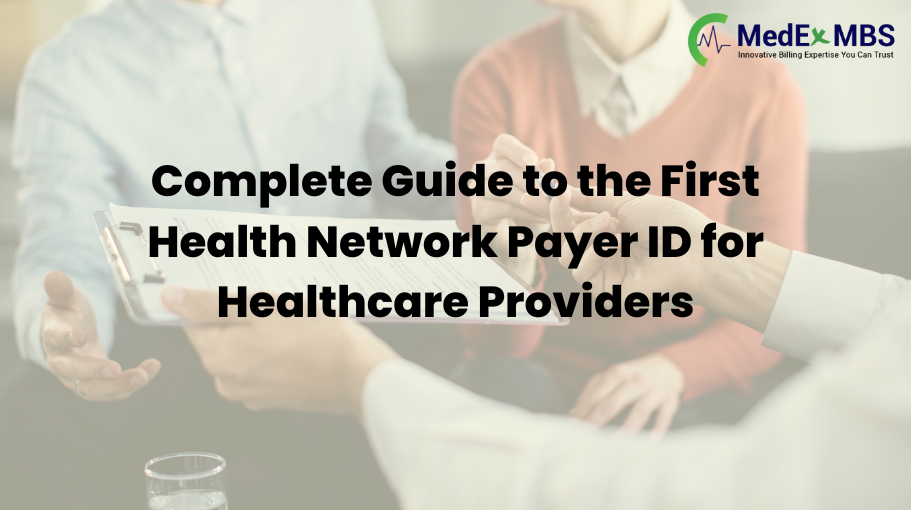Changes in OB GYN Billing Global Periods: What You Need to Know

Only one specific area has been modified. In 2025, new telehealth CPT codes were introduced; however, the adoption by Medicare remains limited. Being aware of these updates safeguards your revenue and ensures compliance, as improper obstetric global billing consistently ranks among the leading causes of claim denials. What is a Global Period in OB GYN? Global-period billing includes prenatal, delivery, and postpartum services consolidated into a single bundled reimbursement for obstetrical care. Instead of billing individually for each prenatal appointment, delivery, and postpartum care, you submit one all-encompassing code that addresses the complete pregnancy experience from the initial prenatal visit to the concluding postpartum examination. The global package typically includes postpartum care for six weeks following delivery, after which additional visits necessitate separate billing. This is distinct from surgical global periods that utilize specific day counts, such as 10-day or 90-day periods. OB-GYN global billing encompasses the entire range of routine pregnancy care, irrespective of duration. Core Codes You Need to Know Global Package Codes Utilize when your practice provides comprehensive pregnancy care: 59510: Cesarean delivery with complete care. 59610: Vaginal birth after previous cesarean with complete care. 59618: Cesarean after attempted VBAC with complete care. Component Codes Utilize when you only manage part of the pregnancy care: 59409/59514: Delivery only (vaginal/cesarean). 59425: Antepartum care, 4-6 visits. 59426: Antepartum care, 7+ visits. 59430: Postpartum care only. Decision Rule: Did you only manage certain aspects while other providers took care of different parts? Utilize component codes. New Telehealth CPT Codes with Limited Medicare Recognition New CPT codes have been introduced for the year 2025, which include 98000-98007 (audio-video), 98008-98015 (audio-only), and 98016 (brief communication). These codes inherently represent telehealth services and do not necessitate modifier 95. However, Medicare currently acknowledges only 98016; 98000-98015 are not reimbursable by Medicare (although some commercial plans may cover them). Virtual consultations that are included in standard prenatal or postpartum care continue to be part of the global package. They cannot be billed separately merely because they are performed through telehealth. However, telehealth consultations for complications or issues that fall outside the standard global package may be billed separately using the relevant evaluation and management codes or code 98016 when applicable. What Did NOT Change? CPT codes remain unchanged from 2024. Global package regulations have not altered. Bundling principles remain consistent. The regulations regarding split and shared visits will persist from 2024, upholding the same substantive portion requirements and the use of modifier FS (applicable only to facility settings). Services that were eligible for separate billing in 2024 will remain eligible for separate billing in 2025. Telehealth Rules for 2025 Bundled services will remain bundled irrespective of the delivery method. Routine prenatal telehealth appointments, virtual postpartum check-ups, and standard pregnancy education sessions held online are encompassed within your global package payment. What Can You Bill Separately? Telehealth visits addressing complications. Virtual care for unrelated medical issues. Coding Requirements Utilize service code 02 for alternative telehealth locations or 10 for a patient’s residence. For traditional E/M codes, most commercial insurers require modifier 95, although Medicare requirements differ by MAC. The recently introduced telehealth CPT codes (98000-98015) do not necessitate the use of modifier 95, as telehealth is inherently encompassed within the code description; nevertheless, it is crucial to highlight that Medicare does not recognize these codes. Important Note Medicare’s expanded telehealth flexibilities (including home as the originating site) are effective until September 30, 2025. Code 98016 supersedes HCPCS G2012 for brief communications. Making the Right Choice: Global vs Component Codes Use Global Codes When Your practice manages the entire pregnancy. Use Component Codes When The patient transitions between practices. You only perform delivery without providing prenatal care. Another practice manages postpartum care. Real Examples A patient moves to a different location during pregnancy: The initial practice charges for the antepartum code, whereas the new practice charges for the global code. Hospital delivery involving a different obstetric group: The prenatal practice charges for the antepartum code, while the hospital group charges for the delivery-only code. You handle the call and provide an unknown patient: Charge the delivery-only code. Essential Modifiers for 2025 Essential Modifiers You Should Use Modifier 25: Significant, separately identifiable E/M service on the same day as another procedure (note that this modifier is often misapplied in OB claims, so ensure proper documentation). Modifier 95: Telehealth services when utilizing traditional E/M codes (not required for new telehealth-specific CPT codes). Modifiers That Don’t Belong on OB Claims Modifier 90: Laboratory services for reference (not applicable during global periods). Modifier 91: Laboratory tests repeated (not applicable during global periods). These laboratory modifiers are irrelevant to obstetric global billing and can cause confusion in claims. Understanding Various Payer Requirements Medicare’s Strategy for OB Global Billing Medicare employs the “MMM” indicator for obstetric global packages, setting them apart from surgical global periods. Telehealth coverage remains available until September 30, 2025, allowing patients to access services from home without geographic limitations. Commercial Insurance Differences Many insurers align with Medicare’s guidelines but may exhibit particular variations: The precise number of postpartum visits included. Distinct telehealth stipulations. State-specific regulations (such as North Carolina’s new F-codes effective after July 1, 2025). It is essential to confirm the policies of individual payers instead of presuming consistent coverage. How to Accurately Bill for OB/GYN in 2025? Standard Pregnancy Care The patient receives comprehensive prenatal care, undergoes delivery, and completes postpartum care within your practice. Code: Employ the correct global code (59400, 59510, etc.) Mid-Pregnancy Transfer If a patient transfers to your practice at 28 weeks, you will provide continuous care and delivery. Code: Apply the global code as you have delivered significant antepartum care along with the delivery. Telehealth for Postpartum Complications Should a patient experience postpartum depression necessitating a virtual consultation beyond standard care? Code: Utilize the appropriate E/M code
Complete Guide to the First Health Network Payer ID for Healthcare Providers

Electronic claims processing serves as the essential foundation of a healthcare practice’s revenue cycle. With over 4 billion healthcare claims processed annually in the United States, it is essential to use the correct payer ID to guarantee prompt payments. The FHNP ID acts as the key for providers to achieve efficient billing and minimize administrative burdens. Providers working in conjunction with First Health networks necessitate particular technical information to ensure that their claims are directed to the correct destination. This guide encompasses all necessary information, from the primary payer ID number to regional coverage differences, enabling medical billing professionals to confidently submit electronic claims. Key Points The network includes providers from First Health, First Choice of the Midwest, and Cofinity. Both Professional/1500 and Institutional/UB claims are accepted The network spans most US states with regional variations Overview The primary payer identification number for Health First Health Plans is 95019. Whether you are submitting Medicare claims or commercial insurance claims, this identification number ensures that your claims are sent to the appropriate processing center. The First Health network operates in accordance with HIPAA-compliant billing regulations and mandates the use of standard code sets, including ICD-10-CM for diagnoses and CPT/HCPCS for procedures. This compliance framework supports the processing of both primary and secondary claims, in addition to Electronic Remittance Advice (ERA). Technical Requirements All claims must adhere to the following requirements: Employ payer ID 95019 for Health First Health Plans Comply with HIPAA transaction standards Incorporate appropriate ICD, CPT, and HCPCS coding Follow AMA coding guidelines and Medicare policies Abide by Correct Coding Initiative (CCI) and Local Coverage Determinations (LCDs) The network also permits custom billing guidelines when standard rules are not applicable, particularly for complex medical situations, while still upholding compliance standards. Network Coverage and Provider Access The primary health network encompasses the majority of US territories, featuring regional differences that providers ought to be aware of. This network is composed of three essential elements: First Health, First Choice of the Midwest, and Cofinity providers. Geographic Coverage Breakdown Network Component Coverage Area Primary Focus First Health Most US states (with specific exclusions) Broad national coverage Cofinity Michigan State-specific network First Choice of the Midwest Idaho and Montana Regional Midwest coverage The secondary coverage encompasses the entirety of Alabama, specific counties in Florida, as well as other states that are not part of the primary network. This framework enables providers to utilize network resources regardless of their location. Provider Network Access This implies that patients with Curative coverage can consult First Health, First Choice of the Midwest, and Cofinity providers without any network limitations. This broadened access enhances patient choice and streamlines participation in the provider network. Claims Submission Requirements Healthcare providers must be aware of specific submission criteria to guarantee that claims are processed accurately. The network supports both Professional/1500 and Institutional/UB claims through the same payer ID system, thereby simplifying processes for multi-service providers. Professional Claims (1500 Forms) Professional claims necessitate: Payer ID 95019 in the appropriate field Provider NPI numbers CPT/HCPCS procedure codes ICD-10-CM diagnosis codes Patient demographic details Service date ranges Institutional Claims (UB Forms) Institutional submissions require: The same payer ID 95019 designation Revenue codes for facility services Bill type designations Principal and secondary diagnosis codes Discharge status when applicable Secondary Claims Processing The network facilitates the processing of secondary claims, allowing providers to submit claims when First Health acts as the secondary payer. This is particularly essential in situations involving Medicare supplements and the coordination of benefits. Providers must ensure that the primary payer information is thoroughly completed prior to submitting secondary claims to prevent any processing delays. Contact Information for Network Access Different inquiries related to the network necessitate distinct contact numbers to reach the appropriate support teams. Being aware of the correct number to call can significantly reduce hold times and enhance resolution efficiency. Special Benefits and Programs Curative members receive enhanced benefits that set the First Health Network apart from conventional insurance offerings. These programs are advantageous for both patients and providers. Member Benefits Structure Curative members enjoy: $0 deductible for in-network services $0 copay for covered services Enhanced prescription coverage Broadened access to provider networks Baseline Visit Requirements Benefits are activated after a Baseline Visit that occurs within 120 days of enrollment. This visit fulfills multiple purposes: Health Evaluation: A comprehensive assessment of the member’s health condition. Care Coordination: Establishing primary care relationships Benefit Activation: Initiating enhanced coverage options Prescription Access: Allowing access to preferred prescription coverage Providers are encouraged to arrange these visits for new Curative members to ensure they receive full access to benefits. The baseline visit also opens avenues for discussions on preventive care and health education. Employer Group Services The network is involved in employer group services, offering added value through partnership arrangements. These services typically encompass: Custom benefit designs Integration of wellness programs Resources for employee health education Specialized provider networks Comprehending these programs enables providers to better assist members of employer-sponsored plans and can lead to increased patient volume through group contracts. Frequently Asked Questions (FAQ) Q1. What is the FH ID? The payer identification number for Health First Health Plans is 95019. This should be used for all submissions of electronic claims. Q2. Which states are included in the First Health Network coverage? The network encompasses the majority of states in the United States, with specific exceptions such as Confinity in Michigan and First Choice of the Midwest in Idaho and Montana. Q3. What types of claims are eligible for submission? Claims can be submitted in both Professional/1500 and Institutional/UB formats. Secondary claims and ERA processing are also supported. Q4. Are secondary claims accepted? Yes, both secondary claims and ERA are accepted. Q5. What is the process for verifying patient eligibility? You can verify patient eligibility using the standard method with payer ID 95019, or you may call the network phone number for manual verification if electronic systems are unavailable. Providers who effectively utilize the FHNP ID system can enhance their revenue
